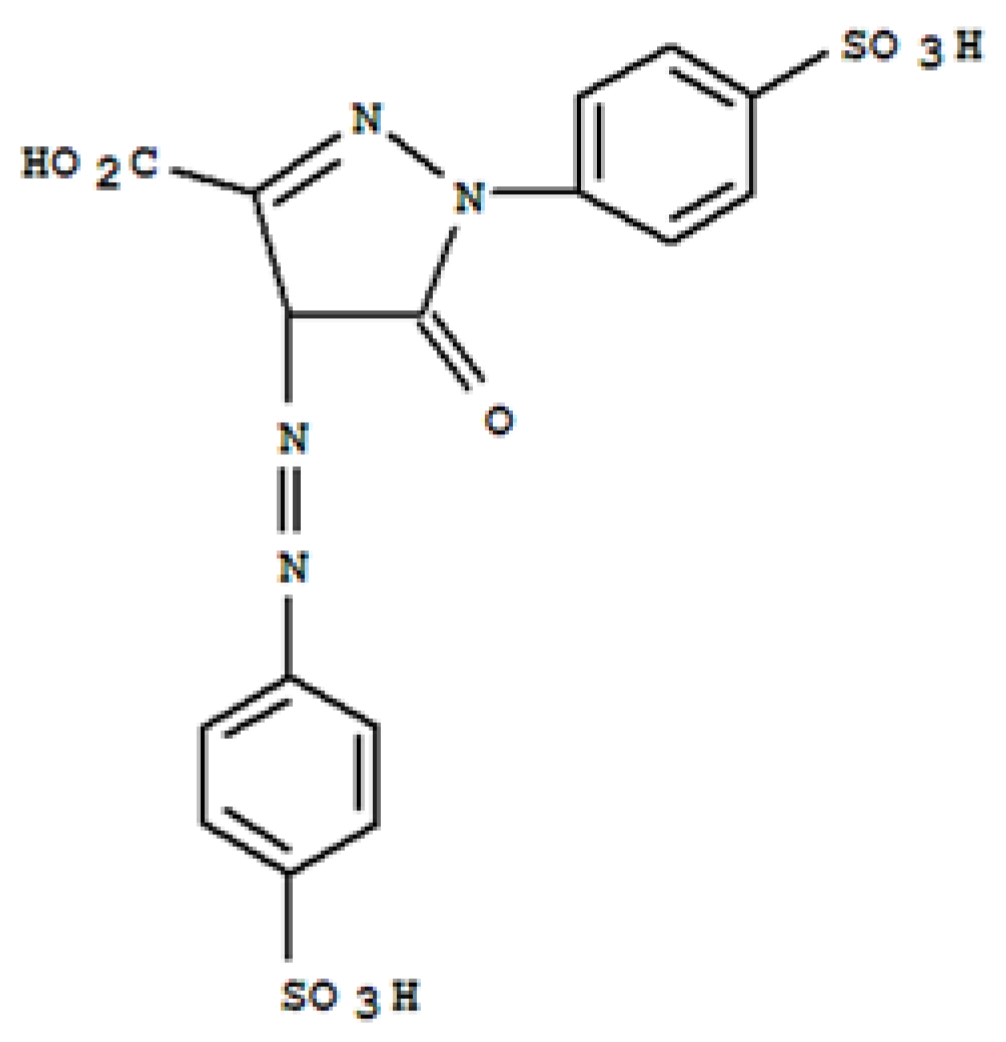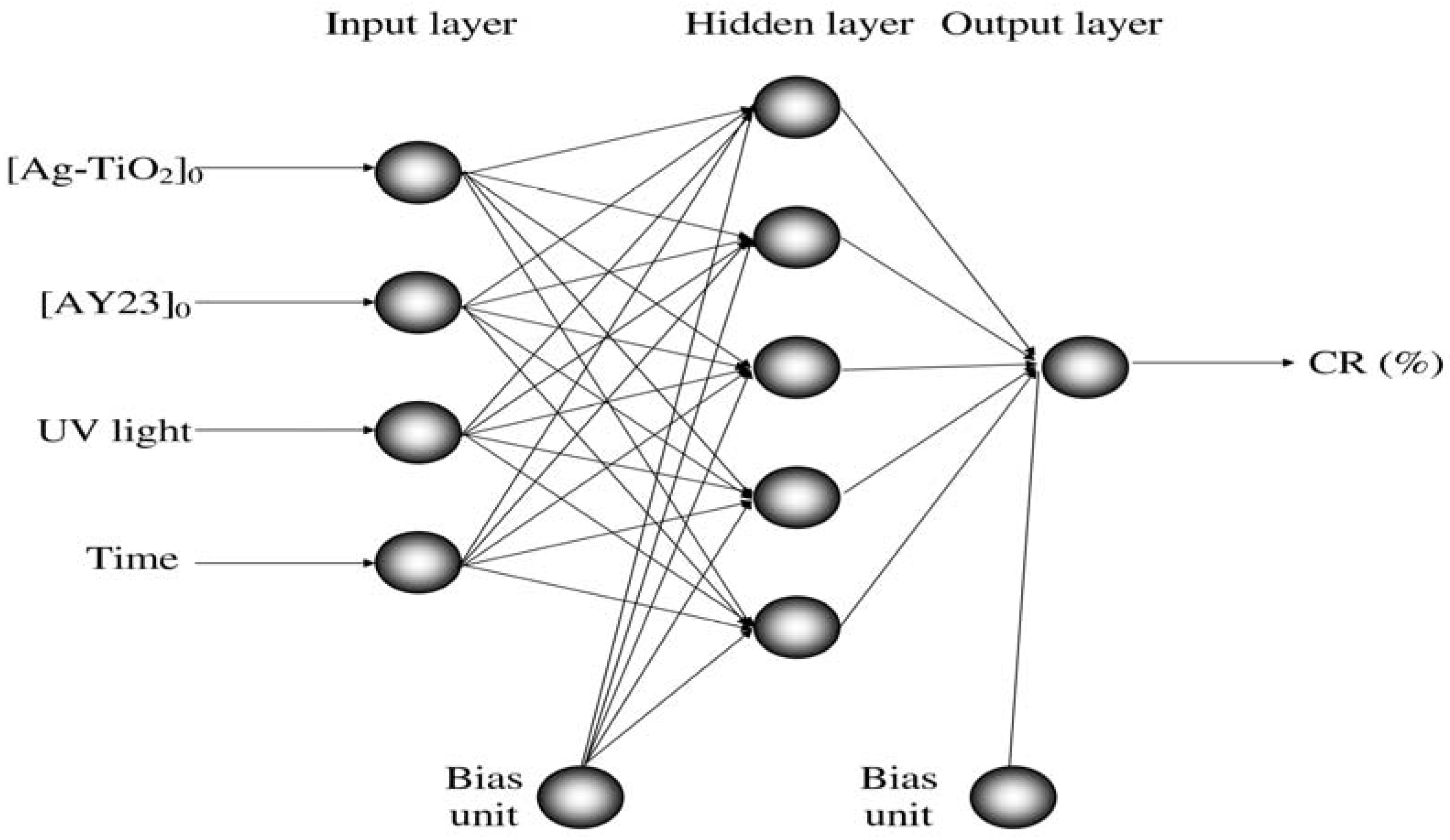ICA and ANN Modeling for Photocatalytic Removal of Pollution in Wastewater
Abstract
:1. Introduction
2. Literature Survey
3. Materials and Methods
3.1. Materials
3.2. Analytical Technique
3.3. Artificial Neural Network Method
3.4. Imperialist Competitive Algorithm Method
3.5. The Dataset
4. Models, Results, and Discussion
4.1. Results and Discussion
5. Concluding Remarks
Author Contributions
Conflicts of Interest
References
- Behnajady, M.A.; Modirshahla, N.; Ghanbary, F. A kinetic model for the decolorization of C.I. Acid Yellow 23 by Fenton process. J. Hazard. Mater. 2007, 148, 98–102. [Google Scholar] [CrossRef] [PubMed]
- Castro, A.L.; Nunes, M.R.; Carvalho, A.P.; Costa, F.M.; Floreencio, M.H. Synthesis of anatase TiO2 nanoparticles with high temperature, stability and photocatalytic activity. Solid State Sci. 2008, 10, 602–606. [Google Scholar] [CrossRef]
- Bagheri, A.R.; Ghaedi, M.; Hajati, S.; Ghaedi, A.M.; Goudarzi, A.; Asfaram, A. Random forest model for the ultrasonic-assisted removal of chrysoidine G by copper sulfide nanoparticles loaded on activated carbon; response surface methodology approach. RSC Adv. 2015, 5, 59335–59343. [Google Scholar] [CrossRef]
- Chang, Y.; Erera, A.L.; White, C.C. Risk assessment of deliberate contamination of food production facilities. IEEE Trans. Syst. Man Cybern. Syst. 2015, 47, 381–393. [Google Scholar] [CrossRef]
- Dil, E.A.; Ghaedi, M.; Asfaram, A.; Hajati, S.; Mehrabi, F.; Goudarzi, A. Preparation of nanomaterials for the ultrasound-enhanced removal of Pb2+ ions and malachite green dye: Chemometric optimization and modeling. Ultrason. Sonochem. 2017, 34, 677–691. [Google Scholar] [CrossRef] [PubMed]
- Fan, C.T.; Wang, Y.K.; Huang, C.R. Heterogeneous information fusion and visualization for a large-scale intelligent video surveillance system. IEEE Trans. Syst. Man Cybern. Syst. 2016, 47, 593–604. [Google Scholar] [CrossRef]
- Jafari, R.; Yu, W. Fuzzy Control for Uncertainty Nonlinear Systems with Dual Fuzzy Equations. J. Intell. Fuzzy. Syst. 2015, 29, 1229–1240. [Google Scholar] [CrossRef]
- Jafari, R.; Yu, W. Fuzzy Differential Equation for Nonlinear System Modeling with Bernstein Neural Networks. IEEE Access 2017, 4, 9428–9436. [Google Scholar] [CrossRef]
- Jafari, R.; Yu, W. Uncertainty Nonlinear Systems Modeling with Fuzzy Equations. Math. Probl. Eng. 2017, 2017. [Google Scholar] [CrossRef]
- Jafarian, A.; Jafari, R.; Khalili, A.; Baleanud, D. Solving fully fuzzy polynomials using feed-back neural networks. Int. J. Comp. Math. 2015, 92, 742–755. [Google Scholar] [CrossRef]
- Khataee, A.R. Photocatalytic removal of C.I. Basic Red 46 on immobilized TiO2 nanoparticles: Artificial neural network modeling. Environ. Technol. 2009, 30, 1155–1168. [Google Scholar] [CrossRef] [PubMed]
- Shirvani Ardekani, P.; Karimi, H.; Ghaedi, M.; Asfaram, A.; Kumar Purkait, M. Ultrasonic assisted removal of methylene blue on ultrasonically synthesized zinc hydroxide nanoparticles on activated carbon prepared from wood of cherry tree: Experimental design methodology and artificial neural network. J. Mol. Liq. 2017, 229, 114–124. [Google Scholar] [CrossRef]
- Kunwar, P.; Shikha, G. Artificial intelligence based modeling for predicting the disinfection by-products in water. Chemom. Intell. Lab. Syst. 2012, 114, 122–131. [Google Scholar]
- Niknam, T.; Taherian Fard, E.; Pourjafarian, N.; Rousta, A. An efficient hybrid algorithm based on modified imperialist competitive algorithm and K-means for data clustering. Eng. Appl. Artif. Intell. 2011, 24, 306–317. [Google Scholar] [CrossRef]
- Yousefi, M.; Darus, A.N.; Mohammadi, H. An imperialist competitive algorithm for optimal design of plate-fin heat exchangers. Int. J. Heat Mass Transf. 2012, 55, 3178–3185. [Google Scholar] [CrossRef]
- Atashpaz-Gargari, E.; Lucas, C. Imperialist competitive algorithm: An algorithm for optimization inspired by imperialistic competition. In Proceedings of the IEEE Congress on Evolutionary Computation, Singapore, 25–28 September 2007; pp. 4661–4667. [Google Scholar]
- Khajeh, M.; Kaykhaii, M.; Sharafi, A. Application of PSO-artificial neural network and response surface methodology for removal of methylene blue using silver nanoparticles from water sample. J. Ind. Eng. Chem. 2013, 19, 1624–1630. [Google Scholar] [CrossRef]
- Wang, H.W.; Lin, H.C.; Kuo, C.H.; Cheng, Y.L.; Yeh, Y.C. Synthesis and photocatalysis of mesoporous anatase TiO2 powders incorporated Ag nanoparticles. J. Phys. Chem. Solids 2008, 69, 633–635. [Google Scholar] [CrossRef]
- Behnajady, M.A.; Modirshahla, N.; Daneshvar, N.; Rabbani, M. Photocatalytic degradation of an azo dye in a tubular continuous-flow photoreactor with immobilized TiO2 on glass plates. J. Chem. Eng. 2007, 127, 167–176. [Google Scholar] [CrossRef]
- Mazaheri, H.; Ghaedi, M.; Ahmadi Azqhandi, M.H.; Asfaram, A. Application of machine/statistical learning, artificial intelligence and statistical experimental design for the modeling and optimization of methylene blue and Cd(II) removal from a binary aqueous solution by natural walnut carbon. Phys. Chem. Chem. Phys. 2017, 19, 11299–11317. [Google Scholar] [CrossRef] [PubMed]
- Asfaram, A.; Ghaedi, M.; Ahmadi Azqhandi, M.H.; Goudarzi, A.; Dastkhoon, M. Statistical experimental design, least squares-support vector machine (LS-SVM) and artificial neural network (ANN) methods for modeling the facilitated adsorption of methylene blue dye. RSC Adv. 2016, 6, 40502–40516. [Google Scholar] [CrossRef]
- Asfaram, A.; Ghaedi, M.; Hajati, S.; Goudarzi, A. Ternary dye adsorption onto MnO2 nanoparticle-loaded activated carbon: derivative spectrophotometry and modeling. RSC Adv. 2015, 5, 72300–72320. [Google Scholar] [CrossRef]
- Asfaram, A.; Ghaedi, M.; Hajati, S.; Goudarzi, A. Synthesis of magnetic γ-Fe2O3-based nanomaterial for ultrasonic assisted dyes adsorption: Modeling and optimization. Ultrason. Sonochem. 2016, 32, 418–431. [Google Scholar] [CrossRef] [PubMed]
- Bagheri, A.R.; Ghaedi, M.; Asfaram, A.; Hajati, S.; Ghaedi, A.M.; Bazrafshan, A. Modeling and optimization of simultaneous removal of ternary dyes onto copper sulfide nanoparticles loaded on activated carbon using second-derivative spectrophotometry. J. Taiwan Inst. Chem. Eng. 2016, 65, 212–224. [Google Scholar] [CrossRef]
- Azad, F.N.; Ghaedi, M.; Asfaram, A.; Jamshidi, A.; Hassani, G.; Goudarzi, A. Optimization of the process parameters for the adsorption of ternary dyes by Ni doped FeO (OH)-NWsAC using response surface methodology and an artificial neural network. RSC Adv. 2016, 6, 19768–19779. [Google Scholar] [CrossRef]
- Chen, C.L.P.; Zhang, T.; Tam, S.C. A novel evolutionary algorithm solving optimization problems. In Proceedings of the IEEE International Conference on Systems, Man, and Cybernetics, San Diego, CA, USA, 5–8 October 2014. [Google Scholar]
- Puntonet, C.G.; Grriz, J.M.; Salmern, M.; Hornillo-Mellado, S. Theoretical method for solving BSS-ICA using SVM. In Proceeding of the International Conference on Independent Component Analysis and Signal Separation, Granada, Spain, 22–24 September 2004; pp. 256–262. [Google Scholar]
- Gorriz, J.M.; Puntonet, C.G.; Salmeron, M.; Ortega, J. New method for filtered ICA signals applied to volatile time series. In Proceedings of the 7th International Work Conference on Artificial and Natural Neural Networks IWANN 2003 Lecture Notes in Computer Science, Menorca, Spain, 3–6 June 2003; Volume 2687, pp. 433–440. [Google Scholar]
- Pothiya, S.; Ngamroo, I.; Kongprawechnon, W. Application of multiple tabu search algorithm to solve dynamic economic dispatch considering generator constraints. Energy Convers. Manag. 2008, 49, 506–516. [Google Scholar] [CrossRef]
- Ghanbary, F.; Jafarian, A. Preparation and photocatalytic properties of silver doped titanium dioxide nanoparticles and using artificial neural network for modeling of photocatalytic activity. J. Basic Appl. Sci. 2012, 12, 2889–2898. [Google Scholar]
- Karul, C.; Soyupak, S.; Clesiz, A.F.; Akbay, N.; German, E. Case studies on the use of neural networks in eutrophication modeling. Ecol. Model. 2000, 134, 145–152. [Google Scholar] [CrossRef]
- Smith, G.N. Probability and Statistics in Civil Engineering; Collins: London, UK, 1986. [Google Scholar]
- Nash, J.E.; Sutcliffe, I.V. River flow forecasting through conceptual models Part I—A discussion of principles. J. Hydrol. 1970, 10, 282–290. [Google Scholar] [CrossRef]
- Slokar, Y.M.; Zupan, J.; Marechal, A.M.L. The use of artificial neural network (ANN) for modeling of the H2O2/UV decoloration process. Dyes Pigment 1999, 42, 123–135. [Google Scholar] [CrossRef]
- Aleboyeh, A.; Kasiri, M.B.; Olya, M.E.; Aleboyeh, H. Prediction of azo dye decolorization by UV/H2O2 using artificial neural networks. Dyes Pigment 2008, 77, 288–294. [Google Scholar] [CrossRef]





| Variable | Range |
|---|---|
| Input layer | |
| Ag-TiO2 initial dosage (g/L) | 0.01–0.05 |
| AY23 initial concentration (mg/L) | 5–60 |
| UV light intensity (W/m2) | 0–60 |
| Irradiation time (min) | 0–60 |
| Output layer | |
| Removal of AY23 (%) | 0–100 |
| Model | Sub-set | RMSE | Ef | Af | R2 |
|---|---|---|---|---|---|
| ANN | Training | 0.04039 | 1.01256 | 1.00103 | 1.00685 |
| Validation | 0.08076 | 1.04562 | 0.99001 | 1.02212 | |
| ICA | Training | 0.18345 | 0.95236 | 0.97852 | 0.94670 |
| Validation | 0.19884 | 0.93545 | 0.94256 | 0.92575 |
| W1 Neuron | [Ag-TiO2]0 | [AY23]0 | UV light | Time | Bias | W2 Neuron | Weight |
|---|---|---|---|---|---|---|---|
| 2 | −0.082 | 3.940 | 14.211 | 1.286 | 9.752 | 2 | −0.154 |
| 3 | 0.070 | 0.204 | −0.092 | 0.221 | −1.344 | 3 | 25.63 |
| 4 | 28.311 | −15.42 | −5.464 | −13.37 | −20.03 | 4 | −0.108 |
| 5 | −2.917 | 2.188 | −2.978 | 0.235 | −0.657 | 5 | −0.270 |
| 6 | 3.043 | 1.473 | 2.946 | 2.971 | 1.648 | 6 | 0.292 |
| 7 | −0.374 | 1.921 | 1.376 | 2.425 | −3.305 | 7 | −0.758 |
| Bias | 21.27 |
| W1 Neuron | [Ag-TiO2]0 | [AY23]0 | UV light | Time | Bias | W2 Neuron | Weight |
|---|---|---|---|---|---|---|---|
| 2 | −0.258 | −0.824 | 0.999 | −0.712 | −0.979 | 2 | 0.341 |
| 3 | 0.003 | −0.864 | −0.483 | 0.726 | 0.775 | 3 | 0.382 |
| 4 | −0.799 | −0.347 | 0.081 | −0.596 | −0.043 | 4 | -0.879 |
| 5 | −0.651 | −0.210 | −0.667 | 0.189 | −0.466 | 5 | −0.514 |
| 6 | −0.448 | 0.465 | −0.994 | −0.369 | −0.161 | 6 | −0.899 |
| Bias | −0.803 |
| Input Variable | Importance (%) |
|---|---|
| Ag-TiO2 initial dosage (g/L) | 10 |
| AY23 initial concentration (mg/L) | 40 |
| UV light intensity (W/m2) | 30 |
| Time (min) | 20 |
© 2017 by the authors. Licensee MDPI, Basel, Switzerland. This article is an open access article distributed under the terms and conditions of the Creative Commons Attribution (CC BY) license (http://creativecommons.org/licenses/by/4.0/).
Share and Cite
Razvarz, S.; Jafari, R. ICA and ANN Modeling for Photocatalytic Removal of Pollution in Wastewater. Math. Comput. Appl. 2017, 22, 38. https://doi.org/10.3390/mca22030038
Razvarz S, Jafari R. ICA and ANN Modeling for Photocatalytic Removal of Pollution in Wastewater. Mathematical and Computational Applications. 2017; 22(3):38. https://doi.org/10.3390/mca22030038
Chicago/Turabian StyleRazvarz, Sina, and Raheleh Jafari. 2017. "ICA and ANN Modeling for Photocatalytic Removal of Pollution in Wastewater" Mathematical and Computational Applications 22, no. 3: 38. https://doi.org/10.3390/mca22030038





